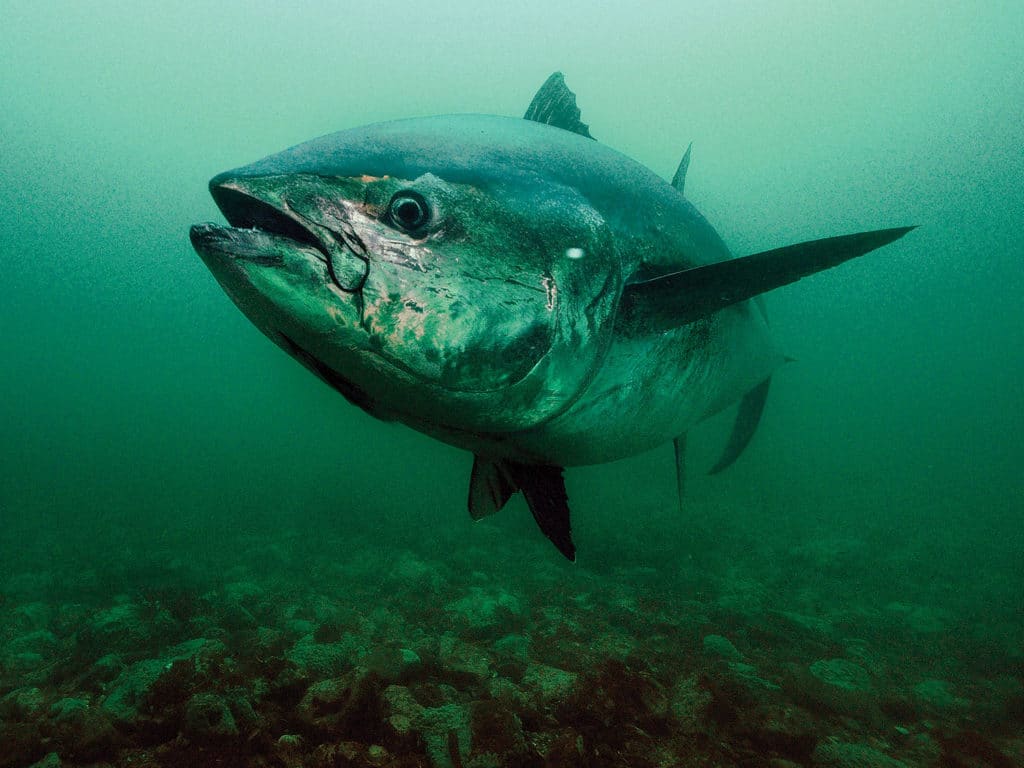
An Atlantic bluefin tuna swims in the waters of Canada’s Gulf of Saint Lawrence.
With the tremendous numbers of bluefin tuna from the Gulf of Mexico to Maine, our recreational and commercial hook-and-line quota can quickly be reached each year, resulting in early season closures, adding to the frustration of U.S. fishermen.
Closures in the recreational trophy bluefin tuna category—greater than 73 inches, curved fork length—typically occur in New England waters each year in July or August, although smaller fish are available the rest of the season. This is to the disadvantage of many anglers, especially north of Cape Cod, Massachusetts, where great numbers of bluefin are found during the fall months, leaving anglers in the Northeast frustrated at missed opportunities for a trophy-size catch.
Recreational fishermen with Highly Migratory Species Angling or HMS Charter/Headboat permits who fish recreationally also experience early season recreational trophy tuna closures. Currently there is a recreational trophy bluefin quota of just 1.8 metric tons for each zone—North Atlantic, South Atlantic and Gulf of Mexico—that quickly gets gobbled up.
Discussions with select parties involved presents the idea of increasing the recreational trophy quota for current zones by creating two new ones: North of the latitude 42-degree line (Chatham, Massachusetts) and from south of the latitude 42-degree line to 39°18’ N (Great Egg Harbor Inlet, New Jersey). This alternative approach could allow each zone to remain open during the good portion of the trophy bluefin bite.
As a result of the early closure, many anglers have elected to obtain a commercial Atlantic Tunas General category permit in order to keep fishing and land a trophy-sized bluefin.
A permitted vessel that has a General category permit can’t retain or sell school-size fish (27- to 47-inch curved fork length) or large school/small medium-sized (47- to less than 73-inch curved fork length) recreationally caught bluefins. A General category permit requires significant expense to obtain the required safety equipment necessary, as well as the applicable state-required permits, to lawfully land and sell bluefin tuna.
HMS Charter/Headboat-permitted vessels with commercial endorsements are the only exception to the rule, allowing anglers on a for-hire trip to comply with all commercial or recreational bag limits. This not only requires the safety equipment to fish commercially, but the captain—who must be on board for all bluefin fishing activities—must also be a USCG-licensed Master, subject to ongoing physicals, drug testing and license-renewal requirements.
The total annual quota for the U.S. Atlantic coast and Gulf of Mexico recreational and commercial bluefin fishermen is 1,272.86 metric tons. The recreational Angling category quota includes tuna ranging in size from 27- to less than 73-inch curved fork length and trophies greater than 73 inches, with recreational subquotas north and south of Great Egg Harbor Inlet.
The commercial quotas are for hook and line, harpoon, longline, trap and purse seine fleets; the General category quota is separated into monthly to quarterly time-specific allocations for the entire Atlantic coast, with no directed fishery allowed in the Gulf of Mexico.
Read more about the IGFA world record bluefin tuna
New England fishermen would prefer moving a portion of the June-to-August quota that is primarily composed of tuna in New England waters to the fall months in a bid to prevent periodic closures. Fall closures in New England result in no boats leaving the dock because there are no other species to target, resulting in a significant economic impact.
North Carolina fishermen also suffer from early-season closures and seek an increase to the January-to-March quota.
The commercial bluefin Purse Seine category quota is no longer used because permits became invalid once the vessels were sold. Part of this quota is leased by the longline fleet—now up to 25 percent—and used for overruns of the commercial quotas noted above.
A portion of this quota could be used to increase the recreational trophy quota, preventing early closures.
NOAA manages and monitors all bluefin landings in an attempt to keep the quota and subquotas in check. Revisions are proposed to maintain equity between recreational anglers and commercial fisherman, guarding the stocks so they stay at sustainable levels.
How to address these problems in order to provide equitable quotas and keep everyone fishing are being discussed, and future NMFS and HMS Advisory Panel meetings will include reviews of Amendment 13 as it relates to this fishery.







